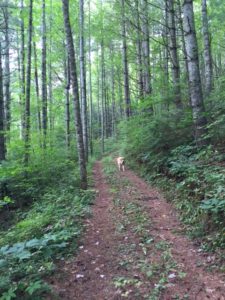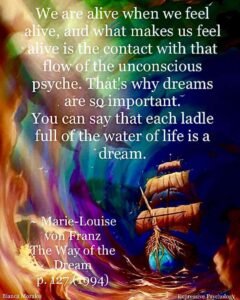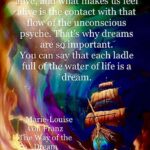 Note: I hope you enjoy this post from over four years ago. It feels like a good time to revisit these ideas.
Note: I hope you enjoy this post from over four years ago. It feels like a good time to revisit these ideas.
To paraphrase Terence McKenna,
“Our world is in crisis because of the absence of consciousness. We need to explore new ideas of who we are.”
I know for a fact that in the middle of my life I was in crisis for the same reason. As within, so without. What might a new idea of who we are look like? And, what difference could a new idea make to our world crisis? Despite my rudimentary understanding of quantum physics, I’d like to use it to try to answer answer these questions.
I’ve never forgotten my high school psychology teacher’s casual remark one day that we only use about a tenth of our brain’s potential. This remark triggered my latent philosopher and I started asking the big questions about life: “What potential lies dormant in me and humanity?” “Does God have anything to do with my psyche?” “What is this force we call God?”
At 17 I fell in love with Christianity. At 27 a spiritual vision dropped me to my knees. At 37 a kundalini awakening dropped me into free fall. At 47 I landed on solid ground via the parachute of Jungian psychology. New worlds of exciting ideas opened to me via my Jungian studies. They pointed me toward dreams, mythology, meditation, world religions, symbolism, alchemy, synchronicity, brain lateralization, and quantum physics.
It was clear to me that all these subjects were related to each other, and the unifying factor seemed to be human consciousness. At the suggestion of my dear friend, Jungian therapist Ann Kennedy, I read The Field: The Quest for the Secret Force of the Universe, by journalist and author Lynne McTaggart. The Field synthesizes some of the latest scientific discoveries related to consciousness. Together they present some mind-blowing findings about who we are and how we can help heal the world.
Finding #1: Each of us has a field of influence on the world and vice versa.
Finding #2: Everything is in connection and balance with the rest of the cosmos via an exchange of energy.
Finding #3: We are beings of light. Our biological processes are driven by photons of light in every molecule of our bodies. The photons are emitted from each molecule to every other molecule in electromagnetic waves via the water in our cells. The water retains, transmits and amplifies information and energy.
Finding #4: Consciousness is a global phenomenon that occurs everywhere in the body, and not simply in our brains. “Consciousness, at its most basic…[is] coherent [unified and ordered] light.” McTaggart, p. 94.
Finding #5: There is an ocean of microscopic vibrations in the space between things. The universe is a heaving sea of energy exchange, with a basic substructure, or field called the Zero Point Field, containing all possible versions of all possible forms of matter. This means that nature is
“…not blind and mechanistic, but open-ended, intelligent and purposeful, making use of a cohesive learning feedback process of information being fed back and forth between organisms and their environment. Its unifying mechanism…[is] not a fortunate mistake but information which…[has] been encoded and transmitted everywhere at once.” McTaggart, pp. 94-5.
“The fact that the human body was exchanging information with a mutable field of quantum fluctuation suggested something profound about the world. It hinted at human capabilities for knowledge and communication far deeper and more extended than we presently understand. It also blurred the boundary lines of our individuality—our very sense of separateness. If living things boil down to charged particles interacting with a field and sending out and receiving quantum information, where did we end and the rest of the world begin? Where was consciousness—encased inside our bodies or out there in The Field? Indeed, there was no more ‘out there’ if we and the rest of the world were so intrinsically connected.” McTaggart, p. 96.
 Finding #6: When we wish for something or intend something, an act which requires a great deal of unity of thought, we have an ability to extend our own coherent thought out into our environment. This represents an almost unimaginable amount of power to create, organize and heal.
Finding #6: When we wish for something or intend something, an act which requires a great deal of unity of thought, we have an ability to extend our own coherent thought out into our environment. This represents an almost unimaginable amount of power to create, organize and heal.
I found this very exciting. So this is what a new idea of ourselves looks like. Next time I’ll share more findings. Meanwhile, I invite your responses to this second question I asked at the beginning: If enough of us become coherent in this new idea of who we really are, what difference could it make to our world crisis?
May the Force be with you.
Image Credits: Google Images






0 Responses
Reblogged this on lampmagician.
Thank you for sharing this with your network, Alaedin.
Fascinating your reading is taking you along this route. My own has went via Jung to Robert A Johnson to “The Secret of the Golden Flower” to…quantum physics! Have just started on Karen Barad’s “Meeting the Universe Halfway”
From the blurb : “reality is not independent of our explorations of it: and reality is not a matter of opinion, but of the material consequences of some cuts and not others made in the fabric of the world…Identities are always formed in interaction,, Ethical practices and consequences are intrinsic to the web”
As to your question, the first thought that springs to mind is “What constitutes enough?” One person changes his/her inner world and spreads their awakening enabling others. Is there a ‘critical mass’ where the change in humanities view becomes inevitable? I would dearly love there to be a truth in Sheldrakes idea that animals learning a task on one side of our planet opens a gateway for others of that species on the other side of the world, and apparently unconnected to them, to show they have somehow acquired the same skill sets. An accessing of universal unconscious material by an increasing number of humans brings forward new dialogues, understandings, new positive choices become available, routes away from the history of conflict. Hopefully also a synthesis of religious thought and a route for the previously agnostic to access a real connection to the”spiritual” nature of existence.
Hi Brian,
Shortly after I discovered Jung, I too went to Robert Johnson, consumed several of his books, then bought, but did not read, “The Secret of the Golden Flower.” It’s still waiting on my shelf! I have no idea why. It comes up so often in my reading.
Anyway, in the early 90’s I stumbled on Zukav’s award winning “Dancing Wu Li Masters” about a mystical interpretation of quantum physics and was hooked! Obviously, not everyone is disposed to take the mental leap from quantum physics to mysticism, but that’s the way my synapses work so I go where they take me. And where my friends take me. Speaking of…. let me know what you think of “Meeting the Universe Halfway.”
I guess there’s no answer to “What constitutes enough?” unless there’s a mathematical equation for what makes up a critical mass in a given population. But the idea of critical mass makes sense to me. My ongoing experiences with synchronicity furnish the proof I need for some kind of underlying field that transmits and receives information at a distance, like Sheldrake’s “morphic fields.” It’s the best idea I have at the moment, although, of course, not original to me!
As you say so clearly, the more of us who bring forward “new dialogues and understandings, the more positive choices become available, routes away from the history of conflict.” For me, this is reason enough to have an open-minded attitude toward the latest scientific research in every area that touches on human consciousness.
And I too hope for a synthesis of “religious” thought some day. Ironically, I suspect it will come from the unexpected quarter of science, which has so long been treated as religion’s enemy! As Yoda might say about our inability to acknowledge the forces that move us, “Unconscious, we humans are.”
Thanks so much for sharing your thoughts.
Unfortunately, the physics and the science in this book (and her others) does not stand up under close scrutiny; I bought a copy when it first came out, tried reading it, loaned it to a friend whose degree meant he was better placed to comment and his verdict was it’s pseudo-science of the worst kind, as it says the metaphysical things we want to hear but none of it ties up with real physics. Disappointing.
I have not read this book but you might check out Jean Emile Charon, a French physicist, who is said to rival Einstein in intellect and nuclear research. “The Spirit” is among the 20 books he wrote.
Thanks for mentioning Charon. I’ve read a book by him but can’t remember the title for the life of me! I do remember certain of his ideas, however, and still find them fascinating definitely worthy of further investigation.
Hi Viv, I don’t agree with your friend, but that’s of no matter. Dissent and dialogue are what keep scientific research going and the new ideas coming. 🙂 I would only be concerned by inquisitions and witch hunts that forcibly squelched new ideas and investigations. Thanks, as always, for your comment.
It would not be for me to stock up on pitchforks but a bit of googling around brought up a lot of very worrying stuff. The author of the book has a magazine called What Doctors Don’t Tell You and while the premise sounds interesting, there’s a lot of dangerous pseudo-science there. Mc Taggart is a journalist, not a physicist, and while that’s not going to preclude her from having opinions and thoughts, it does mean that it puts a very poor spin on her credibility for me. Your high school teacher’s comment about the brain is something that has been debated and researched; usually the idea is that “we only use about 10% of the brain” is what is quoted, and that is completely wrong.
Anyway, take what you want from the book, but for me, it’s irretrievably flawed.
Thanks again for your thoughts, Viv.
Having read as much as I could understand about quantum physics for years, one of the most exciting developments is that it is destroying the divisive either/or controversy between science and religion and leads to a deeper understanding of the both/and reality of spirit-energy of all life. Thank you, Jean for introducing me to Lynn Mactaggart.
I agree. And how synchronistic that you should mention the “divisive either/or controversy between science and religion,” in your comment. I had just finished writing about the same thing in response to Brian’s comment above! Love it when that happens.You’re very welcome. Thank you for writing.
Hi Jeanie, I went to have a look at McTaggart’s book and sped read some sample pages. (Like Viv, I have some concerns). In the past I’ve read Zukav: Dancing Wu Li Masters; An Overview of the New Physics, and many other books of the same stripe. I value the paradox of Heisenberg’s Uncertainty Principle where the wave is also a particle and the effects of the observer upon the observed. There is no question in my mind as to the power of critical mass having a profound influence on the world, hopefully for the benefit of all. Which points to the necessity again of each of us having a responsibility not only to ourselves to shed the ties that bind us, but also to leave the world a better place for future generations. And if we can do this and then see, really see, the unity that is inherent in our lives, of all things big and small, our service in doing the hard inner work is thus meaningful. And, even though Newton may be out of date in some respects, his 2nd or 3rd principle still holds true: for every action there is an equal and opposite reaction.
And good on science for using the boundaries … there is no need for science and religion to be so divided though I think this is lessening …
I’m taking away from your post the need to pray for peace around the world in the hope that my tiny vibration adds to the whole. Thank you.
Thank you for these thoughts, Susan. Well said.
Having been trained to conduct scientific research, and having done my own original research for my doctorate, I too am aware of its many pitfalls and have a healthy skepticism. Nonetheless, ike you, I’ve read enough about quantum physics to be excited about some of the findings you mentioned as well as some newer theories about consciousness that The Field has brought to my attention.
Many of them resonate deeply with me because they confirm insights and intuitions I’ve gained from many years of reading, personal experience, and inner exploration into my own psyche. Obviously, such personal data are irrelevant to hard science, nonetheless they have made and continue to make a significantly positive difference in my life, and they give me great hope for our world.
For example, too many synchronicities to count, as well as many instances of sending out loving thoughts and strong intentions for myself and others, have convinced me of their practical value and the basic unity and connectedness of all forms of life. So even if science some day proves that my experiences, theories and insights do not conform to hard, statistically significant scientific research, I will continue to follow where they have led me so far because they have worked so well for me. Ultimately, I’ve come to trust my “inner guru,” the Self, more than any “authorities” I’ve met in the outer world, at least so far. 🙂
I’m taking away from The Field the same thing you’re taking away from my post: hope, intention, and determination to make a positive difference with “my tiny vibration. ” (I love that!)
Thanks for passing along wisdom from a book I don’t know. I love your spiritual/psychological biography in the fourth paragraph.
I’d love to talk to Vic about the book you’re reading. He had such a balanced view of both sides–quantum mechanics and theoretical physics mixed with deep love and knowledge about Jung, Buddhism, and Hinduism. He was fascinated by and well-read in new consciousness research. I don’t know any other physicists who looked so clearly at both sides, but I’m sure they’re out there.
How do we make these changes in a practical way and have them reach people at the local level. I just volunteered for a shift at the local fireman’s fair–rural, lots of poverty, poor education mixed with a more progressive affluent community that lives near the lake (because they’re part of the tourist industry or have enough money to own lake view property). I was discouraged to find the merry-go-round had been replaced by a ride for three-year-olds that goes round and round while they sit in camo-painted tanks with their very own toy machine guns attached to the front. It tells me how challenging it is to change the collective psyche once we get out of our world of more conscious friends, associates, and questers. Still, it seems to be the only clear choice.
May the Field be with you.
I’d love to know Vic’s perspective on the book. He truly had an amazingly balanced view of all the things you mention above. I especially loved his book on synchronicity. It occurs to me that since my interest in physics has been re-piqued, I’d like to read it again.
I think your example of the difficulty of changing the collective psyche is perfect! I can just see those camp-painted tanks! Ouch. It truly is a matter of becoming more conscious, and the ego tends to shy away from that particular challenge. As you and I know only too well. Thank you for writing. May the Field be with you too, Elaine.